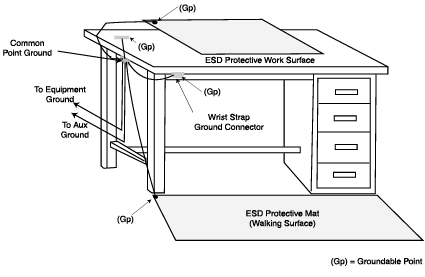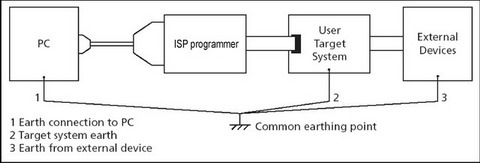Few notes about handling electronic devices.
The following essay tries to explain all possible ways in which you can damage - or destroy - an electronic device without any visible signs.
First an explanation of some terms used here:
An electronic device is any device whose electronic parts may get damaged by improper handling as a result of an electrostatic discharge (ESD) or by equalizing currents. All our programmers fall into this group.
An electrostatic charge may be generated and kept on various objects, e.g. clothes made of artificial fibres, on moving machines bypassed by the air, on various types of plastic packaging, on a sheet of paper from a copier and even on a person. Charging occurs when two surfaces are mutually rubbed, while at least one of them is electrically not conductive. The amount and polarity of the charge depend on different affinities of electrons towards the mutually rubbed materials, on the rubbing force, as well as on the conductivity (mainly due to the humidity) and charge of the surrounding air.
An electrostatic discharge (ESD) is the transmission of an electrostatic charge between objects with different potentials during their mutual contact or by a discharge through an air slot with an electrostatic field. According to the standard, the amount of the electric charge on a person may lead to up to a +/- 8 kV discharge by a direct contact and up to a +/- 15 kV discharge in the case of a discharge through an air slot, which results in peak currents of 1 – 10 A.
An equalizing current is a current between two electric devices interconnected by a conductor when both devices try to acquire a common potential. This current may travel for a very short time (a split second) or continually. In the former case the devices are not connected galvanically, but they are connected, for example, by a capacity coupling or through a separation transformer, and they have different potentials. In the latter case they may be network devices, supplied from the same mains branch, but from two different sockets with different potentials. The difference occurs as a result of an unequal drop in the voltage on the grounding wire as the current passes along it in the mains branch.
And now to the point: ESD

The general rules for handling electronic chips that are sensitive to an electrostatic discharge are mentioned in most electronic chip catalogues, therefore I am going to mention just a few of them here without trying to make the list complete: grounding of the table, of the floor as well as of the handling person through a 500 kOhm resistor; grounding of all instruments; relative humidity of at least 50 %; use of an optional air ionizer. Similar rules, of course, also apply to devices with highly sensitive chips and whose parts can be touched (e.g. with the finger)! It is the case of various "starter kits" without casings, but also the case of all emulators, simulators and programmers that (with the exception of the ‘high-end’ ones) they do not have their external interfaces protected by additional circuits. For example, terminals of an ISP programmer connector might lead directly to the core circuits of the programmer, without protective elements which (if they were expected to really work) would unacceptably increase the prices of particularly low-cost devices.
For most of us the recommendations for handling chips sensitive to the ESD seem out of proportion, and we wonder ones can be ignored. Optimists tend to say that chips will survive it while pessimists say that nothing is sufficiently helpful. It is up to each person to consider the risks resulting from ignoring recommendations. I recommend an always hurrying developer to observe at least some of the cult rituals:
- Try to identify a conductive object, grounded through an approximately 500-kOhm resistor, which you touch before you start working (‘touch me first’ point). If you touch a metal frame with a photo of your mother-in-law, it will almost come alive.
- Try to use clothes, chair upholstering and a table cloth made of natural materials.
- Suppress your longing to touch a connector or an ZIF socket contact at least until after you discharge your electromagnetic (electrostatic) energy into something else. The best thing is to completely avoid touching connectors with your fingers because of the possible dirt/sweat contamination of their contacts.
- Always put the protective sponge on the programming adapters/modules when you remove them from the device (programmer).
- If you pass on chips to others, just throw them. In this way you will prevent the equalization of potentials through the chips. If you do not suffer from a touch aversion towards the other person, an alternative solution is to touch him/her before you pass on the chip to him/her.
This picture show an ideal ESD protected workplace:

Rules for the interconnection of electronic devices
Every developer knows that the ‘ground’ is most important. If two devices do not have a common ground, then equalizing currents flow through them when they are interconnected. They flow, of course, as they want and particularly as you do not want. The intensity of equalizing currents depends on the difference in the potentials of the two devices (ranging from millivolts to hundreds of volts), on their internal impedances and on the impedance of the connecting path (up to a shortcut). If we think about devices powered from a mains supply, the differences in the potentials of the ‘grounds’ may be up to tens of volts at very low impedances of the power supplies. In the case of favourable conditions – particularly the GND/GND connection – wire insulation may get damaged as a result of excessive currents flowing through the wires. The extent of damage also depends on which interface contacts touch each other first. With some exceptions, if the grounds touch each other first, nothing will happen. If the signal contacts touch each other first, damage to the electronic circuit protective elements (blocking diodes) occurs. In general, I recommend you to power devices from the same mains wall socket or to check the differential voltage between the grounds of the interconnected devices. It is suitable to interconnect the grounds of the devices by using a separate wire.
Note: The above mentioned interconnection rules do not concern devices whose interface contains the galvanic separation.
This picture show a recommended wiring of ISP programming workplace:

Notes on the handling of Elnec products
- Higher integration chips are the most liable to damage, therefore at the top of an imaginary damage liability chart are the FPGA-based programmers (without protection devices implemented) and mainly ISP programmers, where signals on an ISP connector are connected directly to the target application. Therefore, if you work with MEMprog2 and SmartProg2 programmers, please observe handling precautions.
- Our higher-grade programmers (BeeHive208S, BeeHive204, BeeHive204AP, BeeHive204AP-AU, BeeProg2, BeeProg2C and BeeProg2AP) are protected by special circuits to withstand an ESD discharge of up to 15 kV.
- In conclusion: Somewhere I have read a claim that "the designer’s experience is proportional to the number of chips he/she destroys". To decrease one’s sense of guilt, I recommend you to identify with this claim . even if its author might have meant "inversely proportional".
Presov, April 2005
updated July 2012
Author: Jan Puobis, Elnec
Return to Application notes


